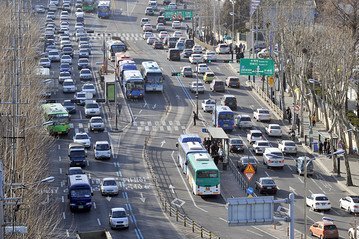Bus Lanes Catch On Across Asia — Could They Work Elsewhere?

The Transjakarta Busway network of empty strips of pavement carved out of the city’s ever-worsening car congestion is the world’s longest of its kind and has become a model for other cities in Asia struggling to ease traffic jams with limited resources.
For years, Jakarta’s elites have opposed the bus network, unable to accept that their chauffeur-driven cars are blocked from a lane that sits empty except when an occasional bus roars through. However, bus commuters have embraced the system: In recent gubernatorial elections, it was the candidate who proposed adding 1,000 buses to the system who won.
Leila Assegaf, a magazine editor in Jakarta, chooses the bus over her car to get to work. She says buses are sometimes crowded and often late, but get her to work in 40 minutes, as opposed to the more than two hours it can take by car, and save her thousands of dollars a year. “While the system is far from perfect, I still like it because it saves me a lot of time and hassle,” Ms. Assegaf said.
Bus lanes have long been common in many U.S. and European cities, but in Asia’s mushrooming megacities they have taken on added significance, providing a quick fix in the absence of money to build a subway or elevated-rail system.
“In the last few years, we have had an explosion of [bus] systems,” said Lloyd Wright, senior transport specialist at the Asia Development Bank. “We can replicate a rail metro at a fraction of the cost using buses.”
China’s Guangzhou’s system, which started operation in 2010, carries close to a million passengers a day. New Delhi’s system was launched in 2008 and now attracts more than 270,000 daily passengers. It wasn’t universally welcomed: One Delhi driver was so angry about losing a car lane that he filed a public-interest suit to have it scrapped, claiming car owners shouldn’t be slowed down because they are more important. The Delhi High Court didn’t agree with him.
An increasing number of cities are turning to bus rapid-transit systems, which use fenced-in lanes and platforms just for buses. In Asia, more than 25 new systems are scheduled to start operation soon, from Dhaka in Bangladesh to Davao in the Philippines as well as Ulan Bator, Mongolia, and Bhopal, India.
Related News


